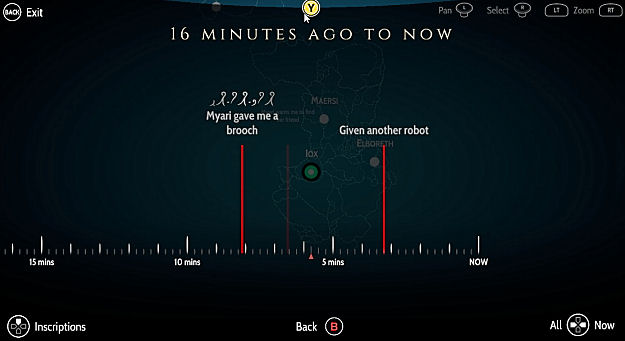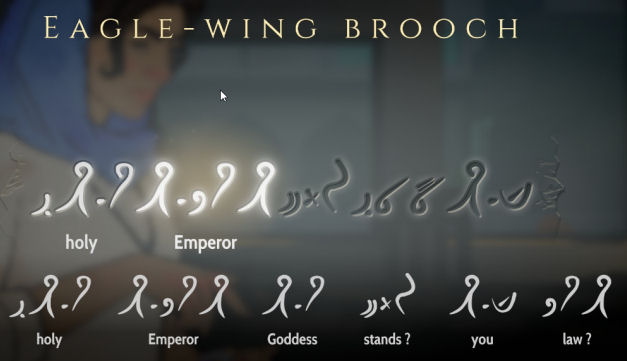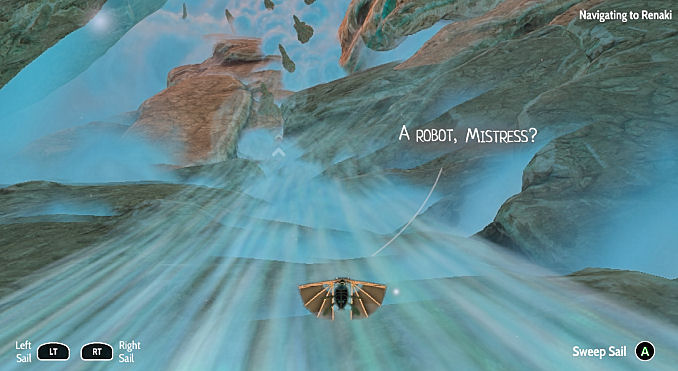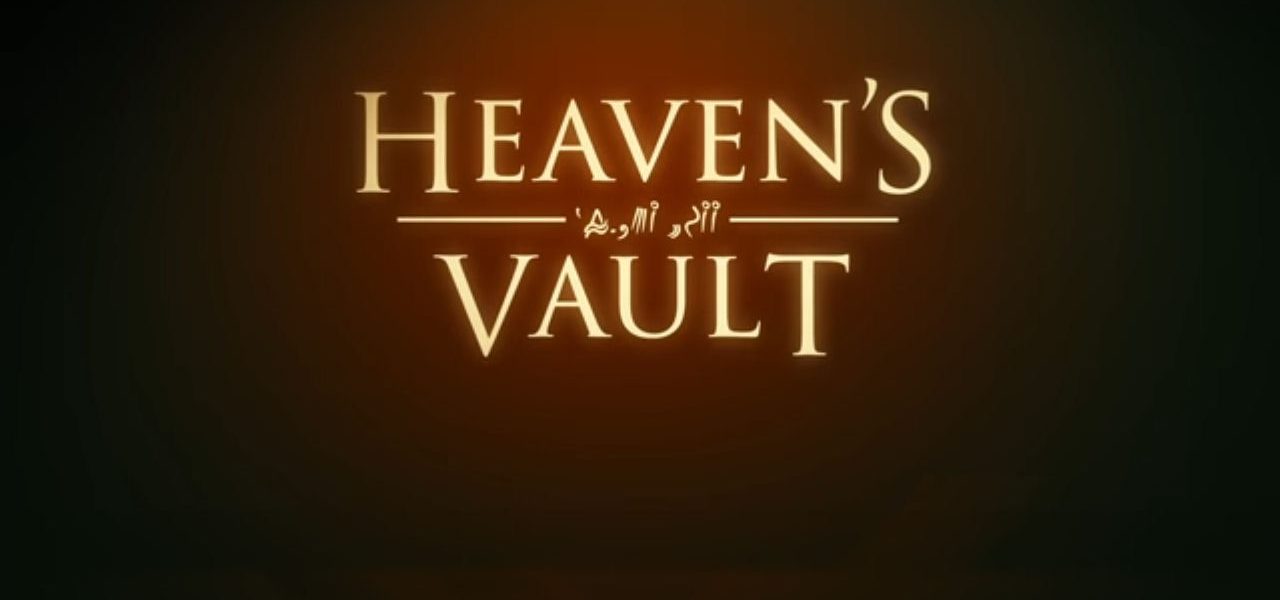Heaven’s Vault Review
With your trusty robot by your side, explore the Nebula and discover the secrets it holds
Category: Review
Written by: Cindy Kyser on April 16, 2019
Developed by: inkle LTD
Published by: inkle LTD
Release Date: April 16, 2019
Genre: Archaeological Sci-Fi Adventure
Platform: Windows, PS4
Our story begins when archaeologist Aliya Elasar is summoned to the University of Iox and tasked with locating a missing roboticist named Renba. With only an ancient brooch as a clue and a robot named Six by her side, she embarks on an exploratory journey through a region of space known as the Nebula.
Heaven’s Vault was created by inkle LTD. They are best known for 80 Days – a globetrotting adventure released in 2015 that was met with high praise (JA review) . In 2016, they released Sorcery! – a four-part narrative adventure filled with swordplay and magic (JA review).
Like past inkle titles, Heaven’s Vault is a choice-driven narrative. You play out the story, making decision after decision, and the game evolves into a personalized experience. You choose your path through the Nebula; which characters you interact with; the tone of each conversation and the fate of artifacts. At many points in the game, I had to decide if I should trade a valuable artifact for information that might or might not help me. At other points, I had to choose from different actions that changed the fate of another character. Your game is saved on exit so, once a decision is made, there is no going back. Having completed my journey, I find myself wondering how the story might have changed, had I made different decisions. If you want to look back at what you’ve discovered and review the events of your own journey, you can refer to a timeline provided as part of the game’s interface.

While the Nebula has only a few populated areas, it is a vast region of space. You discover a host of archaeological sites with clues as to Renba’s fate. Like a trail of bread crumbs, each artifact or site that you examine leads to additional facts and areas to explore. With the help of Six, you sort out Renba’s journey and begin to piece together the history/origin of the Nebula itself.
Your clues are inscribed in a language of The Ancients and, as in real archaeology, you start with guesswork as you translate the symbols. Over time, you build a vocabulary of known symbols and your translation skills improve. What makes this so interesting is that, as in real life, your guesswork is based on context and comparing new symbols to known symbols. At any point in the game, you can travel to the library at the University of Iox and consult with an expert on specific inscriptions. The game timeline also provides a way to revisit and refine previous translation attempts.

After choosing your next destination from a map, you travel within the Nebula by sailing on rivers of gas/ice that connect various points. While riding these rivers, your speed is best if you remain in the center of the flow by adjusting your right and left sail. You also have a “Sweep Sail” command that provides a temporary burst of speed. Directional arrows and instructions from Six guide you through a very complicated landscape. While some journeys are along known routes, others involve searching rarely traveled areas to find new sites. As you gather artifacts during your journey and add to your knowledge of history, it becomes easier to pin down a new site’s location.

Heaven’s Vault is a very long and complicated story that requires the patience of an archaeologist. Travel between locations takes time and there are no shortcuts. It is a long trip to sail from one end of the Nebula to the other and I found myself planning my itinerary to avoid backtracking. Drifting off-center in the river or taking a wrong turn delays your arrival even further. Looking for unknown sites is also a bit cumbersome as you traverse river branch after river branch in hopes of stumbling upon a place of significance.
Your time spent looking for The Vault is extended by the sheer volume of dialog between characters. The only voice-overs are in the form of an occasional musing by Aliya to add background to her current situation. There is no voice acting for the conversations which I thought was a positive design decision. For me, it was easier to read the continuous stream of verbal exchanges. To listen to that much dialog would have been a hardship.
Although the game interface is simple, it takes some getting used to in the beginning. I usually play with a keyboard and mouse but found that a controller worked best for Heaven’s Vault. At times, you guide Aliya using the joystick or WASD keys. At other times, a single keystroke will move her towards a location. Gameplay is a combination of actively guiding Aliya or clicking and watching her walk. There is no command to make her run and, except for sailing, the pace of the game is slow.
I enjoyed Heaven’s Vault very much. The translation feature provided an interesting twist and held my interest through the 20+ hours it took me to complete the game. Despite spending that much time in the Nebula, my Steam achievements were only at 50% which means I left a lot of stones unturned. At each site in the game, I attempted to search every possible corner and surface for inscriptions or artifacts. I left each site not knowing if I had found everything or if I had missed something important.
At the very end, not all mysteries in the Nebula are fully explained. I remain unsure if this is due to choices I made or if this was intentional by inkle. Archaeology is more art than science and, as a result, it is a mix of inference and speculation. It is difficult to fully describe the past when your source materials consist of a few artifacts and ruins that have eroded over time.
Heaven’s Vault is a game I would enjoy replaying, when time permits. When you start a new game, you can opt to retain your current knowledge of the language of The Ancients. Although you can start your learning curve from scratch, the idea that you can carry your translation skills forward into the next game is very appealing. It makes the idea of replaying with different choices much more attractive.
Grade A-
|
+ Choice-driven story evolves based on your decisions and actions
+ Absence of voiceovers lets you read at your own pace and enjoy the original music
+ Language translation and sailing provide interesting diversions from the standard point-and-click adventure format
+ Lots of adventuring for your money, with features that encourage replay
– The pace of the game is slow so this is not a game for those in a hurry
|
 |
Trailer: (PS4)
OS: Windows 7 or later
Processor: SSE2 instruction set support
Memory: 4 GB RAM
Graphics: Nvidia Geforce GTX 660 / AMD Radeon HD 7850, 2+ Gb of vram
DirectX: Version 10
Storage: 5 GB available space
Additional Notes: Not recommended for Intel HD GPUs


Leave a Reply